
The decompression and anchoring exercises of the previous two chapters are boot camp—basic training for restoring your body’s natural physical foundation. In this chapter, a quartet of wrap-up exercises gives those basics a final flourish, integrating and affirming the training and tying it all together. I think of this wrap-up quartet as topping up the tug-of-war between axial and appendicular, giving the tension between the two an extra push for good measure. Spend time with the movements and postures of Chapters 3 and 4, but round out and reinforce what you’re trying to accomplish with the four exercises of this wrap-up.
1. FOUNDER
The founder is absolutely basic to the entire Foundation Training toolkit. It is the granddaddy of postures—the primary recruiter of the posterior chain of muscles, the key to ensuring that the body hinges at the hip, and a core movement for decompression, and it is probably the best way I know of to put yourself on the fast track to spinal stability, hip mobility, and a body in better balance.
Stand with your feet facing forward as much as three feet apart, with the outside lines of the feet parallel to one another and your weight on your heels. Get anchored, lifting the toes of both feet, then lowering them to the floor. Stand tall, with your chest up and your sternum raised.
Unlock your hips, hinge them backward, and pull them out behind your heels, making sure your abdomen stays long. Knees bend slightly but stay well behind the toes.
As you feel tension in the lower back, unscrew the shoulders by opening the hands, separating the fingers wide, and turning the thumbs outward.
From this position, move your arms forward touching the hands together at the fingertips as you counterbalance the backward-hinging hip movement.
Start the tug of war: Reach forward with your arms, pull back with your hips—simultaneously—while keeping your chest high and your weight pressed into your heels.
Hold the posture as you breathe a high, wide, full decompression breath and maintain the expansion on the exhale.
Stand up.
MINIMUM: one repetition three times a day

A. Begin in a wide stance with feet firmly pressing toward the ground, take 3 decompression breaths.
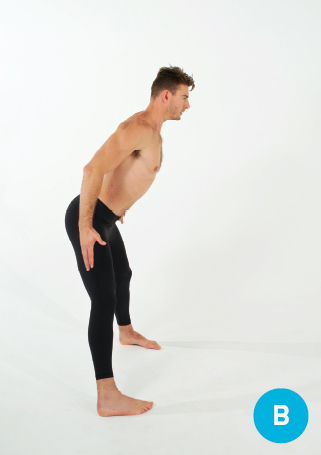
B. Open the arms, expand your chest, and hinge your hips back well behind your feet. Allow the knees to gently unlock. The knees must remain above or behind the ankles.
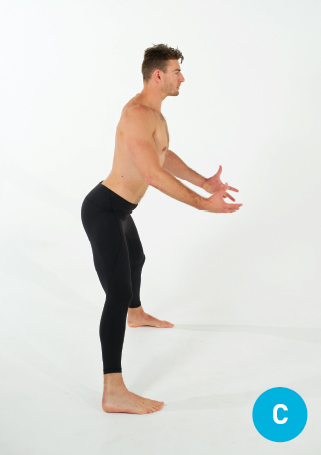
C. Scoop arms forward and up as you hinge the hips farther back.
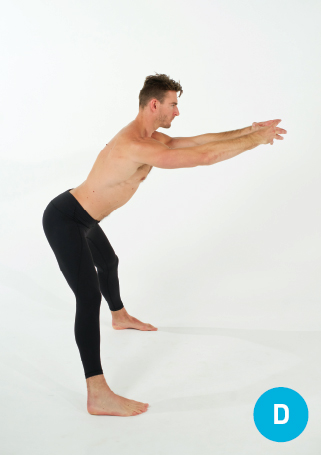
D. Once you find a challenging counterbalance between the hips and arms, hold the pose for 3 to 5 more decompression breaths.
2. WOODPECKER
Woodpeckers—the avian kind, not the exercises—have what’s called a zygodactyl foot, with two toes facing front and one facing back, so that they always appear forward-looking as they climb. The Foundation Training posture approximates the look by hinging at the hip and splitting the legs forward and back, lengthening the gluteal muscles supporting and propelling the back-pulling hip and adding leverage to the posterior chain.
Stand with your feet parallel and your hips square, arms open and turned out at your sides. Take a high, wide, full decompression inhalation and hinge at the hips with one leg stepping forward; then pull the hip back. The front foot is flat on the floor and the front knee is behind the ankle; the foot of the back leg is raised at the heel for the added leverage. Bring the arms forward for counterbalance, the hands touching at the fingertips.
Do several decompression breaths in this position, then return to a standing position: feet parallel and hips square, arms open and turned out at the sides. Breathe again and hinge at the hips, bringing the other leg forward, then pulling that hip back. With back heel raised and front knee behind the ankle, bring the arms forward and up for counterbalance, touching the hands at the fingertips. After several decompression breaths in this position, return to the standing position.
MINIMUM: one repetition three times

A. Step into a tall split stance with the hips squared and the front knee slightly bent. Take 3 decompression breaths.
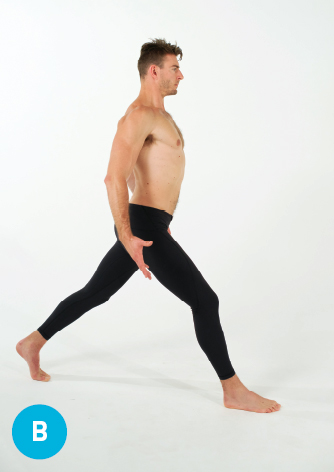
B. Open the arms and chest as you hinge the hips back to load the posterior chain of your front leg.
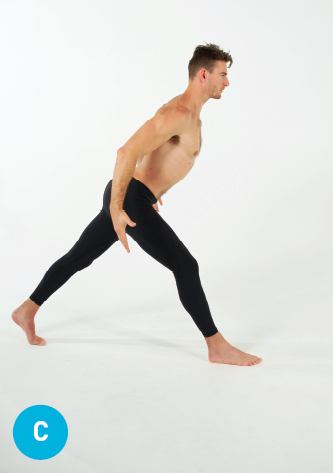
C. Once you feel a stretch and fatigue in the hamstrings and low back, bring your arms forward to counterbalance deeper.
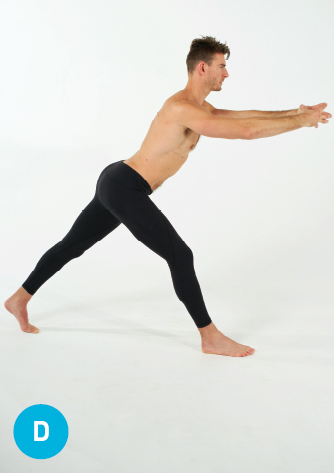
D. Keep the chin back and chest up for 3 to 5 more decompression breaths.
3. WOODPECKER ROTATION
This exercise adds a rotational move to the woodpecker posture in order to force the gluteal and adductor muscles actively to support the whole weight of the torso. The aim is to make the glutes the strongest part of the body, as they should be.
From the top of the posture—that is, hinged at the hip with one leg forward and its foot flat on the floor, knee behind the ankle, with the back foot raised at the heel, and with arms stretched out in front of you, fingertips touching—begin rotating your pelvis in the direction of the front leg. Keeping all of your weight on that leg, and with the front heel gripping the floor, let your torso and arms follow the pelvis in its rotation till the entire upper body has pivoted about ten inches and no more than twelve inches. Rotate back inward, maintaining the contraction in the gluteal muscles and the pressure in the front heel.
Do three rotations, then return to a standing position and begin the posture with the other leg forward.
MINIMUM: one repetition (three rotations) three times

A. Step into a tall split stance with the hips squared and the front knee slightly bent. Take 3 decompression breaths.
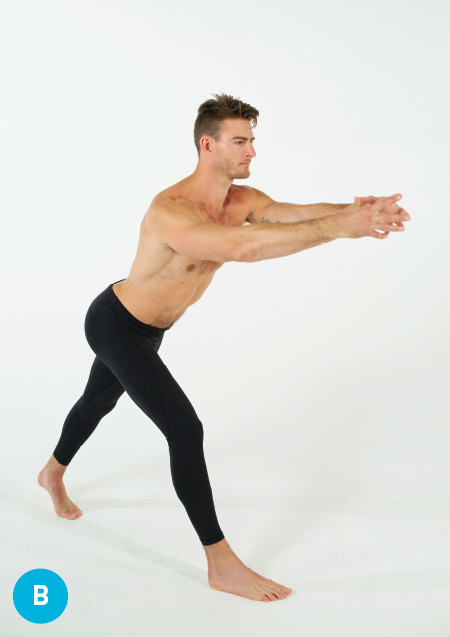
B. Open the arms and chest as you hinge the hips back to load the posterior chain of your front leg.

C. Bring the arms forward, load all your weight to the front leg and rotate three to six inches to the same side as the front leg. This should make your glute muscles fatigue quickly.
4. INTEGRATED HINGES
These graduated hinging movements remind the body that movement originates in the core and that the hip is not just the body’s great shaker but also its main mover—and that the right movement is a hinge, especially, for example, when you are lifting something.
Stand with the feet shoulder-width apart and parallel, your weight on the heels and your toes gripping the floor.
Bend your elbows and hold them close to your sides with your hands in front of and just below the shoulders.
Decompress: Breathe high, wide, and fully and anchor the lower body, pressing your weight onto your heels, raising and spreading your toes, and tensing your inner thighs.
Unlock the knees, keep your weight in your heels, and without moving your spine, hinge slightly at the hip, pulling the hips back behind the heels.
Pull the hips farther and farther back, in stages.
Drive your weight into your heels and push against the floor as you lift your torso, also in stages, and return to a neutral position.
MINIMUM: one repetition three times a day

A. Stand tall with legs in any width position you choose—wide, narrow, hip width, shoulder width.
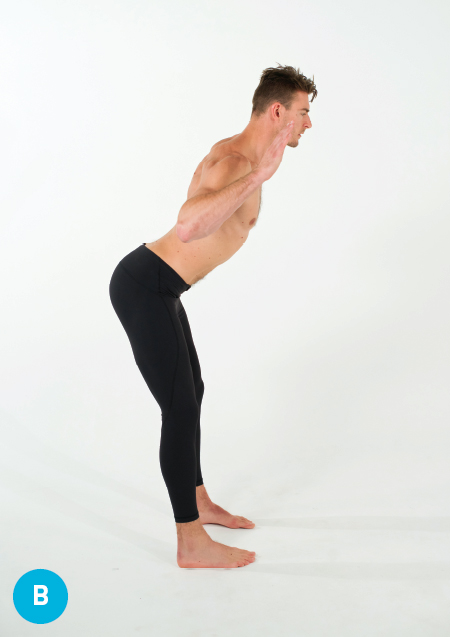
B. Bend your elbows to bring your hands by your ears. This is another chance to keep your chest wide and your back strong as you hinge.
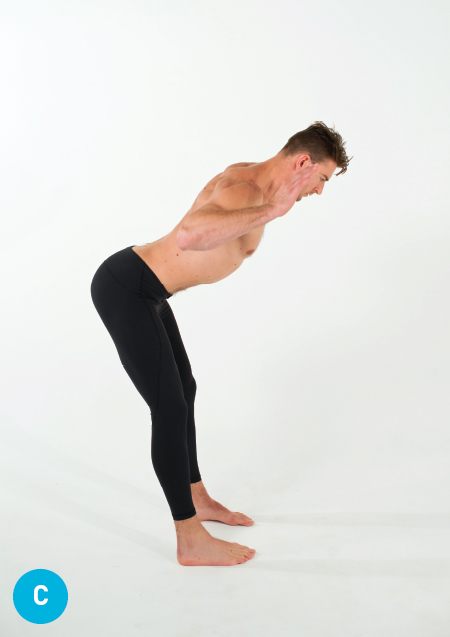
C. Keep your spine long, still, and stable as your hips do all of the work to hinge you back and forth slowly. Try to perform 5 to 10 integrated hinges for each rep.
This wrap-up quartet of exercises provides the finishing touch only to a sequence of exercises that need to be repeated frequently. It cannot be stressed too often or too strongly that restoring your body’s natural strength and flexibility comes not through intensity of effort but through consistency. The body responds to how well and how persistently the postures and movements of Foundation Training are performed, not to how hard you do them. As the next chapter details, the aim is to make these postures and movements your normal way of holding yourself structurally and moving muscularly.